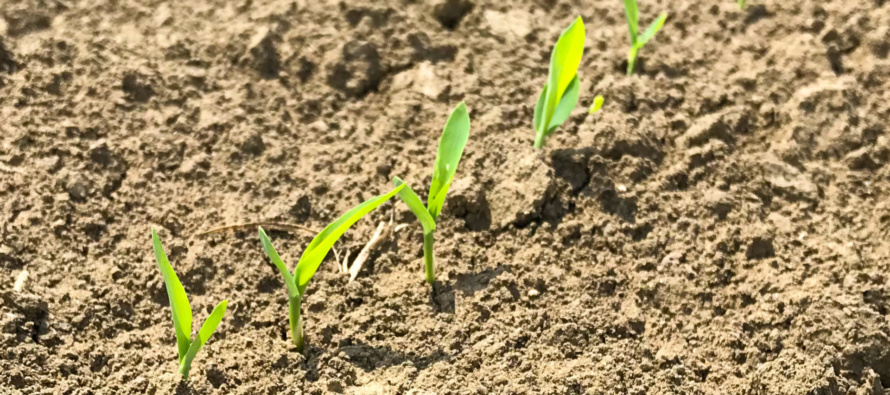Grain Sorghum Planting Recommendations for 2021

Related Articles
- 2010 Soybean And Corn Variety Trial Data 3
- Fertilizing Cotton with Poultry Litter 5
- Flag The Technology 0
Latest Tweets
Grain sorghum is a crop receiving renewed interest from many Mississippi growers primarily due to strong demand and market prices in 2021. This article discusses key planting and management practices needed to successfully grow a productive sorghum crop and get it off to a good start this spring.
Grain sorghum is a warm-season grass crop that is very drought and heat tolerant compared with other major crops, making it well-adapted to hot, dry climates. Since sorghum is typically about 30% less productive than corn in favorable environments, it is best suited to grow in the Midsouth in dryland fields, or where productivity is marginal. However, it is sensitive to low soil pH. Sorghum is also a viable option for planting in May and June if rainfall delays planting, or when double-cropping following wheat or other small grains. Grain sorghum produces many mutual benefits when grown in a rotation system with soybean, cotton, or other crops.
The primary limitations of sorghum in our region include few herbicide options for weed control, sensitivity to injury from off-target glyphosate movement, prevalence of insect pest issues (including Sugarcane aphid), and susceptibility to kernel sprouting when rainy, humid environmental conditions persist prior to harvest.
- It is essential to plant sorghum into a weed-free seedbed, so all weeds should be controlled with tillage or a preplant burndown application prior to planting. Herbicide options for postemergence weed control in sorghum are limited, and sorghum has no herbicide-resistant traits that allow application of non-selective herbicides as salvage treatments.
- While sorghum is normally responsive to early planting, its seedling vigor and hardiness are considerably weaker than corn. Soil temperature determines germination rate and sorghum requires soil temperatures warmer than 65 F to ensure rapid, dependable emergence. Soil temperature should be measured at target planting depth early in the morning to assess germination conditions. The daily low temperature can also be used to characterize the suitability for planting. Likewise, sorghum seedlings are vulnerable to soil saturation during establishment. Thus, utilization of raised beds and planting when temperatures support rapid growth will enhance establishment of a healthy stand.
- Grain sorghum is not particularly responsive to planting rates over a reasonable range. This is because sorghum possesses ability to tiller and thus compensate given favorable environmental conditions. Thus, it is generally recommended to strive for a modest population goal of 40,000 to 70,000 plants per acre to optimize productivity of dryland sorghum. This allows sorghum to better tolerate stress common during July and August without sacrificing yield, plant, and/or stalk health. High sorghum density will reduce plant health and increase yield loss if you encounter drought or other stress. If you have irrigation potential, population can be increased to 70,000 to 80,000 plants per acre. However, since yield potential of sorghum is about 30% less than corn, planting corn is generally a better option if irrigation is available. Sorghum can be grown in a variety of row widths or patterns, but rows 30 inches or less will be about 10% more productive than wide rows.

- Sorghum seed should be generally be planted 1.25 to 1.5 inches deep, depending primarily on soil moisture content. Deeper depth is fine for sandy soils, particularly if soil moisture is very dry. However, deep planting will hinder stand establishment when conditions are cool and wet.
- Preemergence herbicide treatments are the foundation of successful weed control in sorghum. Postemergence herbicide options are limited, particularly for grass weed species, so herbicide timing is critical. Delaying all herbicide applications until after sorghum emergence often results in weeds emerging at the same time as sorghum. These weeds will be difficult or even impossible to control, increase expense, and reduce sorghum yield. Therefore, application of residual herbicides at planting is essential in sorghum production. Atrazine plus a Group 15 herbicide such as metolachlor/S-metolachlor, Outlook, or Warrant are traditional standard treatments for preemergence application in sorghum. However, the addition of mesotrione, such as in Lexar EZ or Halex GT, can enhance broadleaf weed control and are strong options for preemergence herbicide applications in sorghum. Common postemergence treatments for weed control in sorghum include Huskie plus atrazine, Permit, and quinclorac.
- Nitrogen recommendations for sorghum are similar to those for corn, except the yield goal is less, so lower rates are needed. Nitrogen rates will vary by soil texture with 1.0 to 1.3 lbs. of N per bushel of yield goal generally needed. Clay soils require higher nitrogen rates compared with sandy soils to achieve a similar yield. Split application methods are generally advised in order to enhance efficiency in our region, since high rainfall promotes nitrogen loss. Surface application of nitrogen as urea is more risky than in corn because applications will occur when temperatures are higher and rainfall less frequent. This considerably increases the risk of volatility losses. Accordingly, surface-applied urea should be treated with NBPT to help reduce volatility loss before rainfall incorporates the fertilizer.




Let me tell You a sad story ! There are no comments yet, but You can be first one to comment this article.
Write a comment